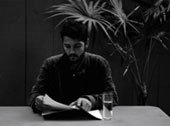Mario Garcia Torres
dal 16/12/2009 al 20/2/2010
Segnalato da
16/12/2009
Mario Garcia Torres
Fundacio Joan Miro', Barcelona
Under the title 'It's embarrassing, but for some time now I've only had title ideas in English', artist presents Unspoken Dailies, a sketch in film form, and two of his best known projections, What happens in Halifax stays in Halifax and Transparencies of the non-act. These two projections are accompanied by related materials, such as archival footage from 1459 Le Marchant. Halifax, filmed by David Askevold, and the enigmatic The Plan (Press kit), 1969-1970, by Oscar Neuestern. In this group of works, Garcia Torres reflects on secrecy and immateriality using subtle narrative and aesthetic strategies in a double exercise in the archaeology of silence.

Mario García Torres (Monclova, Mexico, 1975) is a Mexican artist living in Los Angeles who is interested in revisiting the history of Conceptual Art.
Under the title It's embarrassing, but for some time now I've only had title ideas in English, he presents Unspoken Dailies, a sketch in film form, and two of his best known projections, What happens in Halifax stays in Halifax (in 36 transparencies) and Transparencies of the non-act. These two projections are accompanied by related materials, such as archival footage from 1459 Le Marchant. Halifax, filmed by David Askevold, and the enigmatic The Plan (Press kit), 1969-1970, by Oscar Neuestern. In this group of works, García Torres reflects on secrecy and immateriality using subtle narrative and aesthetic strategies in a double exercise in the archaeology of silence.
What happens in Halifax stays in Halifax (in 36 transparencies) is a piece that resulted from the research García Torres undertook between 2004 and 2006 on a certain half-forgotten episode in Conceptual Art. The work, which was shown at the 52nd Venice Biennale, consists of a screening of black-and-white subtitled transparencies that evoke a stunning, opaque silence, as in the best-kept secrets. Two different stories converge in the piece: firstly, the assignment that in 1969 the conceptual artist Robert Barry gave a group of art students in Halifax, Canada, which consisted of thinking up a "shared idea" that was to be kept secret, even from Barry himself, and secondly, the research carried out by García Torres on the current state of the work, since according to Barry, the idea would remain alive only if it stayed within the confines of the original group. For García Torres, Halifax... tells the story of his own research rather than explaining Barry's piece: "It is the story of the group of people who turned out to be part of a work of art."
When watching Halifax... the viewers ask questions to which they receive no answer, and the secrecy ends up by surrounding them, creating a layer over the different silences contained in the piece and over the sensual cadence of the images, texts, and cuts to black. It is a work of great resonance and ambiguity on the limits of memory and immateriality.
In Transparencies of the non-act, Mario García Torres draws his inspiration from an article published in Art News in 1969 by the art critic Kiki Kundry about an unknown young artist called Oscar Neuestern who was particularly concerned with "the absolute" and whose artistic career was constructed upon the concept of "absence." Titled "The Ultimate Non-Act," the article described an artist who was interested in the visual provided it was transparent, who did not allow his works to be photographed, and who declared that, despite not yet having altogether achieved it, true transparency was only possible in the "ultimate non-act." Fifty black-and-white slides with varying degrees of opacity and superimposed texts make up this exercise on silence produced by García Torres with self-confessed apathy. This was the artist's way of trying to emulate the radical attitude of the mystical Oscar Neuestern, who wanted to arrive at productivity through renunciation. But did Neuestern really exist?
Lastly, the very recent Unspoken Dailies, a work on time and silence, what is not said and what is forgotten, is based on a lecture written by the artist some years ago, that was then adapted into a film script and eventually turned into a 16 mm film. The film features actor Diego Luna reading the script to himself for the first time. The version shown at Espai 13 is a sketch from Unspoken Dailies in which the artist himself appears reading the script. It was shot some weeks earlier in Super 8 and lasts a mere three minutes: a short film on the silence to come.
Press Department telephone: +34 934 439 484
e-mail: press@fundaciomiro-bcn.org
Opening 17 December 2009
Fundacio Joan Miro'
Parc de Montjuic s/n, Barcelona
Opening hours: Tuesday to Saturday, 10.00 - 19.00 (October - June)
Sundays and public holidays, 10.00 - 14.30
Closed on Mondays (except public holidays)



